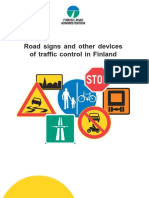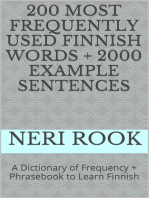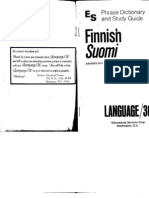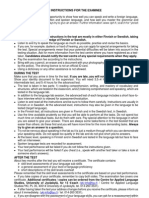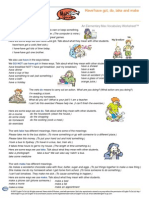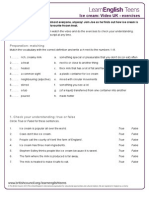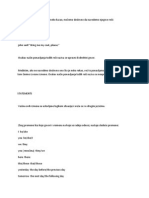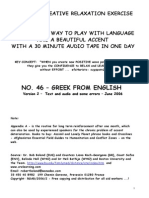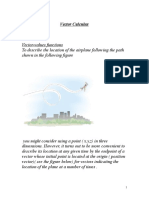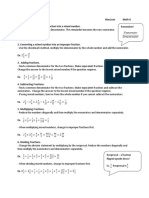Finnish Verbs
Finnish Verbs
Uploaded by
Alexandra WeissCopyright:
Available Formats
Finnish Verbs
Finnish Verbs
Uploaded by
Alexandra WeissOriginal Description:
Copyright
Available Formats
Share this document
Did you find this document useful?
Is this content inappropriate?
Copyright:
Available Formats
Finnish Verbs
Finnish Verbs
Uploaded by
Alexandra WeissCopyright:
Available Formats
Finnish Verbs
Verb types
Verbs are a class of words that are to express actions, processes and
conditions. In Finnish, there are six types of verbs (V means any vowel):
Type 1 (-Va/ -V, e.g. lukea, puhua, etc.)
Type 2 (-da/-d, e.g. saada, syd, etc.)
Type 3 (-la/-l, -na/-n, -ra/-r, -sta/-st, e.g. tulla, menn, surra, nousta,
etc.)
Type 4 (-Vta/-Vt, e.g. haluta, pelt, pelata etc.)
Type 5 (-ita/-it, e.g. tarvita, mainita, hallita, etc.)
Type 6 (-eta/-et, e.g. paeta, kyet, etc.)
Tense
In addition Finnish verbs decline according to 4 tenses:
the present tense (e.g. puhun)
the preterite or past tense (e.g. puhuin)
the perfect tense (e.g. olen puhunut)
the past perfect or pluperfect tense (e.g. olin puhunut)
Mood
Finnish verbs also have 4 moods:
the indicative (e.g. puhun)
the conditional (e.g. puhuisin)
the imperative (e.g. puhu!)
the potential (e.g. puhunen)
The indicative can be used with all 4 tenses, the conditional and the potential
with the present and past, and the imperative only with the present.
The three most important forms
In order to use a verb in Finnish, there are three basic forms of that verb that
need to be remembered:
the infinitive form
the 1st person singular present form
the 3rd person plural present form
Personal endings for the verbs
In Finnish, there are 6 personal endings for verbs:
Singular Plural
1st person -n -mme
2nd person -t -tte
3rd person -V or - -vat or -vt
NB! These endings look like the negative verb forms, minus the e- in the
beginning. In addition, when using the 3rd person forms, you must
remember vowel harmony.
The negative verb
There is a so-called negative verb in Finnish, which declines according to
person and, in effect, removes the affirmative verb's personal suffix,
e.g. puhun 'I talk' becomes en puhu 'I don't talk'.
Transitive and intransitive verbs
When using Finnish, proper attention should be paid as to whether and
intransitive verb (never takes an object) is needed or a transitive one (may
take an object). For instance, the sentenceJohtajamme erotettiin is
completely different in meaning from Johtajamme erosi. In the first one, the
infinitive is erottaa, and the manager was dismissed (he was asked to leave),
whereas in the second one the infinitive form is erota and he quit (he left on
his own). To somewhat facilitate this, I have put up a chart comparing the
two.
You might also like
- Finnish VocabularyDocument202 pagesFinnish VocabularyHaja Sherief100% (7)
- Finnish Language For ForeignersDocument30 pagesFinnish Language For ForeignersMaria Magdalena Biela100% (1)
- Finnish Language Test 2013Document1 pageFinnish Language Test 2013be_kind4allNo ratings yet
- Missä Mistä Mihin - Location Cases - Finnish Grammar - Uusi KielemmeDocument5 pagesMissä Mistä Mihin - Location Cases - Finnish Grammar - Uusi Kielemmeadel hussenNo ratings yet
- App2brain Cheat Sheet Finnish Basic VerbsDocument3 pagesApp2brain Cheat Sheet Finnish Basic VerbsJuLie Ann DeGuzman Geslani100% (1)
- Finnish VerbsDocument23 pagesFinnish VerbsRoshan Budhathoki75% (4)
- Kato Hei - Puhekielen Alkeet (PDFDrive)Document186 pagesKato Hei - Puhekielen Alkeet (PDFDrive)Nathan Francis100% (1)
- Roadmap For Learning FinnishDocument2 pagesRoadmap For Learning FinnishkbuestezxepjuujwsnNo ratings yet
- Finnish Health Care GlossaryDocument8 pagesFinnish Health Care GlossaryVeronicaGelfgrenNo ratings yet
- General Specification FR Roads and Bridges Construction - KSADocument143 pagesGeneral Specification FR Roads and Bridges Construction - KSAJay Alvin Dagpin Denoyo78% (18)
- Finnish Human Body and Anatomy GlossaryDocument8 pagesFinnish Human Body and Anatomy GlossaryVeronicaGelfgren100% (1)
- Finnish Traffic Signs PDFDocument12 pagesFinnish Traffic Signs PDFMuskan KhanNo ratings yet
- Finnish GrammarDocument59 pagesFinnish GrammarAlejandro Garcia100% (5)
- Finnish Food GlossaryDocument12 pagesFinnish Food GlossaryVeronicaGelfgren100% (1)
- 200 Most Frequently Used Finnish Words + 2000 Example Sentences: A Dictionary of Frequency + Phrasebook to Learn FinnishFrom Everand200 Most Frequently Used Finnish Words + 2000 Example Sentences: A Dictionary of Frequency + Phrasebook to Learn FinnishRating: 5 out of 5 stars5/5 (1)
- Suomi-Startti MateriaaliDocument48 pagesSuomi-Startti MateriaaliSoumya Das100% (2)
- Swedish PhrasesDocument19 pagesSwedish PhrasesAlexandra Weiss100% (8)
- Finnish TutorialDocument32 pagesFinnish Tutorialgreat2readNo ratings yet
- Etappi 2 MateriaaliDocument42 pagesEtappi 2 MateriaaliMorteza DianatfarNo ratings yet
- Finnish Language Summer2013Document4 pagesFinnish Language Summer2013Qutab QaziNo ratings yet
- The Difference Between Mikä and MitäDocument31 pagesThe Difference Between Mikä and MitäTricia Ruiz100% (5)
- Finnish Learning BookDocument12 pagesFinnish Learning BookMihai Voinea100% (7)
- FinnishDocument60 pagesFinnishRavi Vararo100% (1)
- Survival Finnish Booklet 3.9.2021Document45 pagesSurvival Finnish Booklet 3.9.2021diluna adeesha100% (1)
- Finnish Clothes and Accessories GlossaryDocument8 pagesFinnish Clothes and Accessories GlossaryVeronicaGelfgren100% (1)
- The Genitive Case - Genetiivi - Finnish Grammar - Uusi KielemmeDocument13 pagesThe Genitive Case - Genetiivi - Finnish Grammar - Uusi Kielemmeadel hussenNo ratings yet
- 初级芬兰语Document65 pages初级芬兰语KyaxavierNo ratings yet
- Finnish Christmas TraditionsDocument6 pagesFinnish Christmas TraditionsIrinhNo ratings yet
- Finnish For Foreigners 1Document237 pagesFinnish For Foreigners 1danielagonzalezhiguitaNo ratings yet
- Survi-Materiaali 28.8.2019 PDFDocument46 pagesSurvi-Materiaali 28.8.2019 PDFHamedFazeliNo ratings yet
- Finnish Phonology PDFDocument8 pagesFinnish Phonology PDFMetaleiroNo ratings yet
- Finnish, Suomi (Language 30 - Phrase Dictionary and Study Guide, Photocopy)Document22 pagesFinnish, Suomi (Language 30 - Phrase Dictionary and Study Guide, Photocopy)Alura AbraderNo ratings yet
- Kyl Mä Hoidan 3-8-2020Document11 pagesKyl Mä Hoidan 3-8-2020Rechel Artiaga100% (1)
- The Finnish Verbtypes - Overview - Uusi KielemmeDocument1 pageThe Finnish Verbtypes - Overview - Uusi Kielemmeadel hussenNo ratings yet
- Superkoulu Harjoitus-Week 8 A1 SDocument14 pagesSuperkoulu Harjoitus-Week 8 A1 SestellaNo ratings yet
- Cases in FinnishDocument6 pagesCases in FinnishGina Contillo50% (2)
- 10 Finnish For Foreigners 1 ExercisesDocument285 pages10 Finnish For Foreigners 1 ExercisesSergio CardozoNo ratings yet
- Työkalusanasto: Suomesta Englanniksi, Ruotsiksi Ja VenäjäksiDocument5 pagesTyökalusanasto: Suomesta Englanniksi, Ruotsiksi Ja VenäjäksiVeronicaGelfgren100% (1)
- The Imperfect Tense - Past Tense - Imperfekti - Uusi KielemmeDocument17 pagesThe Imperfect Tense - Past Tense - Imperfekti - Uusi Kielemmeadel hussenNo ratings yet
- 226-Finnish Courses 2014Document13 pages226-Finnish Courses 2014Manuel Valente0% (1)
- Finnish Idioms - IntroductionDocument22 pagesFinnish Idioms - IntroductionOrsi SimonNo ratings yet
- YKI Instructions For The ExamineeDocument2 pagesYKI Instructions For The ExamineeTradewarstories Puh-Lease100% (1)
- Finnish WorkbookDocument2 pagesFinnish WorkbookVvNo ratings yet
- Finnish Aged Care GlossaryDocument25 pagesFinnish Aged Care GlossaryVeronicaGelfgren100% (1)
- Finnish Dental Health GlossaryDocument5 pagesFinnish Dental Health GlossaryVeronicaGelfgrenNo ratings yet
- Finnish GrammarDocument122 pagesFinnish Grammarjunipersgrao90% (10)
- First Finnish Reader For Beginners Volume2 Bilingual For Speakers of English With Embedded Audio TracksDocument17 pagesFirst Finnish Reader For Beginners Volume2 Bilingual For Speakers of English With Embedded Audio TracksvadimznNo ratings yet
- Finnish GrammarDocument33 pagesFinnish GrammarMetaleiro100% (2)
- Suomi 1 ADocument65 pagesSuomi 1 Alvmengke1994100% (4)
- A Step by Step Guide To Passing The YKI Test Nov 2023 V 1.1Document73 pagesA Step by Step Guide To Passing The YKI Test Nov 2023 V 1.1Thach VoNo ratings yet
- Agi Risko - Beginner's FinnishDocument314 pagesAgi Risko - Beginner's Finnishİlker100% (9)
- Finnish 1A: Opettaja: Heidi Laurikainen 7.9.2020Document22 pagesFinnish 1A: Opettaja: Heidi Laurikainen 7.9.2020prateekisbest100% (3)
- Infographics Collection For Learning FinnishDocument9 pagesInfographics Collection For Learning FinnishChâu Lê Khánh CườngNo ratings yet
- I Want To Learn Finnish FASTDocument1 pageI Want To Learn Finnish FASTquantum vietNo ratings yet
- Finnish Sports Nouns GlossaryDocument5 pagesFinnish Sports Nouns GlossaryVeronicaGelfgrenNo ratings yet
- First Finnish Reader For Beginners Bilingual For Speakers of English With Embedded Audio TracksDocument26 pagesFirst Finnish Reader For Beginners Bilingual For Speakers of English With Embedded Audio Tracksvadimzn100% (3)
- Fsi ConversationalFinnish TextbookDocument716 pagesFsi ConversationalFinnish TextbookMelissa Burd94% (17)
- Conversational Finnish Quick and Easy: The Most Innovative Technique to Learn the Finnish Language.From EverandConversational Finnish Quick and Easy: The Most Innovative Technique to Learn the Finnish Language.No ratings yet
- Training Materials: International Teachers: 1. What Are You Going To Use For Your Lessons?Document1 pageTraining Materials: International Teachers: 1. What Are You Going To Use For Your Lessons?Alexandra WeissNo ratings yet
- Posloviii KruzerrrriiiiiDocument2 pagesPosloviii KruzerrrriiiiiAlexandra WeissNo ratings yet
- Suffixing Ez and Az: - Repeating Demonstrative PronounsDocument4 pagesSuffixing Ez and Az: - Repeating Demonstrative PronounsAlexandra WeissNo ratings yet
- Where Are All My Grammars!Document1 pageWhere Are All My Grammars!Alexandra WeissNo ratings yet
- I Upišite Na Praznine Am, Is Ili AreDocument2 pagesI Upišite Na Praznine Am, Is Ili AreAlexandra WeissNo ratings yet
- Max HavedoDocument2 pagesMax HavedoAlexandra WeissNo ratings yet
- Ice Cream: Video UK - Exercises: Preparation: MatchingDocument2 pagesIce Cream: Video UK - Exercises: Preparation: MatchingAlexandra WeissNo ratings yet
- Test For Potential TeachersDocument4 pagesTest For Potential TeachersAlexandra WeissNo ratings yet
- DomaciDocument2 pagesDomaciAlexandra WeissNo ratings yet
- A Day in The Park!Document1 pageA Day in The Park!Alexandra WeissNo ratings yet
- Positive Negative: Write Sentences in Present Perfect SimpleDocument1 pagePositive Negative: Write Sentences in Present Perfect SimpleAlexandra WeissNo ratings yet
- PasivDocument7 pagesPasivAlexandra WeissNo ratings yet
- DomaciDocument2 pagesDomaciAlexandra WeissNo ratings yet
- Slaganje VremenaDocument8 pagesSlaganje VremenaAlexandra WeissNo ratings yet
- Visum - Forlengelse Og Ny Innreise - EngelskDocument2 pagesVisum - Forlengelse Og Ny Innreise - EngelskAlexandra WeissNo ratings yet
- 5 RazredDocument1 page5 RazredAlexandra WeissNo ratings yet
- How To Learn Modern GreekDocument58 pagesHow To Learn Modern GreekAlexandra WeissNo ratings yet
- UN Women Personal History Form-P11Document8 pagesUN Women Personal History Form-P11Alexandra WeissNo ratings yet
- Nemacka Gramatika Za SvakogaDocument11 pagesNemacka Gramatika Za SvakogaAlexandra WeissNo ratings yet
- Ref.1 Math - Ee..kevinDocument3 pagesRef.1 Math - Ee..kevinHary Kriz0% (1)
- TaskList 1stclassDocument18 pagesTaskList 1stclassMob KingsNo ratings yet
- Chapter 14 - Vector CalculusDocument86 pagesChapter 14 - Vector CalculusRais KohNo ratings yet
- ICT Worksheet 2Document5 pagesICT Worksheet 2kumiNo ratings yet
- Cable Selection Guide For Process InstrumentationDocument3 pagesCable Selection Guide For Process InstrumentationyoungfpNo ratings yet
- Cubic FunctionDocument19 pagesCubic Functionjoshua balansagNo ratings yet
- AMM 15 ManualDocument16 pagesAMM 15 ManualJamirNo ratings yet
- The Fraction Cheat SheetDocument1 pageThe Fraction Cheat SheettxcrudeNo ratings yet
- Thermal Physics: by MST - CreatorDocument22 pagesThermal Physics: by MST - Creatorupgradetutors00No ratings yet
- Somas Valve GuideDocument2 pagesSomas Valve Guidefarm numNo ratings yet
- COS1512 Tutorial 103 2016Document8 pagesCOS1512 Tutorial 103 2016Lina Slabbert-van Der WaltNo ratings yet
- Principais Depositos Minerais DNPM CPRMDocument14 pagesPrincipais Depositos Minerais DNPM CPRMluizhmo100% (1)
- Session 4 SOQL and SOSLDocument15 pagesSession 4 SOQL and SOSLshubhamchavhan0143No ratings yet
- Computing Center Management System (CCMS)Document25 pagesComputing Center Management System (CCMS)Pulkit JainNo ratings yet
- PP2 Term 2Document7 pagesPP2 Term 2Nick GikundaNo ratings yet
- SPE110726-PIP Low Gravity CrudeDocument7 pagesSPE110726-PIP Low Gravity CrudeHugo VeraNo ratings yet
- Uncertainty Analysis of Constant Amplitude Fatigue Test Data Employing The Six Parameters Random Fatigue Limit ModelDocument8 pagesUncertainty Analysis of Constant Amplitude Fatigue Test Data Employing The Six Parameters Random Fatigue Limit ModelAwan AJaNo ratings yet
- 1 s2.0 S0022391322006904 MainDocument8 pages1 s2.0 S0022391322006904 MainceramicameoNo ratings yet
- Electrical Discharge Machining (EDM)Document28 pagesElectrical Discharge Machining (EDM)Jayant SisodiaNo ratings yet
- Chapter 1 Ws G12Document2 pagesChapter 1 Ws G12Vinushree SanthoshkumarNo ratings yet
- PT - Mathematics 10 - Q2Document3 pagesPT - Mathematics 10 - Q2JOBERT HERRERANo ratings yet
- DBT Lab Exam FaqsDocument3 pagesDBT Lab Exam FaqsSumit Tembhare0% (1)
- Motor Insulation and WindingsDocument14 pagesMotor Insulation and Windingskitchu007No ratings yet
- Gujarat Technological UniversityDocument2 pagesGujarat Technological UniversityChavda jayesh laljibhaiNo ratings yet
- Java Lab 3Document7 pagesJava Lab 3my scribd account AccountNo ratings yet
- HLK-10M05 DatasheetDocument15 pagesHLK-10M05 DatasheetCSC DARKHOLANo ratings yet
- LR 1702021903 Tesla ReprintDocument4 pagesLR 1702021903 Tesla ReprintDinca SimunicNo ratings yet
- Vanning ReportDocument4 pagesVanning ReportAhmadmasrokanNo ratings yet
- CapsulesDocument2 pagesCapsulesسلطان القلحNo ratings yet












